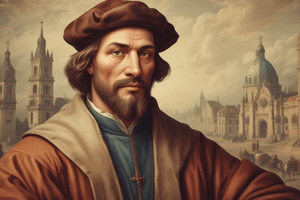Podcast
Questions and Answers
What was a significant characteristic of Protestantism during its spread?
What was a significant characteristic of Protestantism during its spread?
Which theological perspective is most closely associated with John Calvin?
Which theological perspective is most closely associated with John Calvin?
What was one major outcome of the Catholic Reformation?
What was one major outcome of the Catholic Reformation?
Which social phenomenon was accelerated by the Protestant Reformation?
Which social phenomenon was accelerated by the Protestant Reformation?
Signup and view all the answers
What was a result of the spread of Protestant ideas in Reformation England?
What was a result of the spread of Protestant ideas in Reformation England?
Signup and view all the answers
What was a primary motivation behind the Catholic Reformation?
What was a primary motivation behind the Catholic Reformation?
Signup and view all the answers
Which aspect distinguished Calvinism from other Protestant denominations?
Which aspect distinguished Calvinism from other Protestant denominations?
Signup and view all the answers
How did the spread of Protestantism influence social norms during the Reformation?
How did the spread of Protestantism influence social norms during the Reformation?
Signup and view all the answers
What was one significant social impact of the Protestant Reformation during its early years?
What was one significant social impact of the Protestant Reformation during its early years?
Signup and view all the answers
What role did the social structure play in the spread of Protestantism?
What role did the social structure play in the spread of Protestantism?
Signup and view all the answers
Study Notes
Spread of Protestantism
- Emerged in the 16th century, challenging Catholic Church practices and authority.
- Key figures include Martin Luther, who initiated the movement with his 95 Theses in 1517.
- Rapid spread due to the printing press, allowing for wider distribution of Reformation ideas.
- Varieties emerged including Lutheranism, Calvinism, and Anglicanism.
Reformation England
- Marked by Henry VIII's break from the Catholic Church in the 1530s to annul his marriage.
- The Church of England established, combining Catholic traditions with Protestant reforms.
- Elizabeth I's reign solidified Protestantism, promoting a middle way between Catholicism and radical Protestantism.
Calvinism
- Founded by John Calvin in Geneva, emphasizing predestination and the sovereignty of God.
- Influenced the development of Reformed churches across Europe, particularly in France and the Netherlands.
- Calvinist beliefs promoted a disciplined, moral society characterized by hard work and piety.
Catholic Reformation
- Response to Protestant Reformation, aiming to reform internal Church practices and doctrines.
- The Council of Trent (1545-1563) set forth reforms and clarified Catholic doctrine.
- Jesuits, founded by Ignatius of Loyola, played a critical role in revitalizing the Catholic Church and spreading its teachings.
Social Impact
- Protestantism encouraged literacy and individual interpretation of the Bible.
- Led to shifts in social structures, promoting the rise of a middle class and increasing secularism.
- Psychological effects included increased individual responsibility in personal faith and morality.
Witch Hunts
- Increased social tension and fears in the wake of the Reformation led to a rise in witch hunts across Europe.
- Beliefs in demonic influence and heresy contributed to widespread persecution, particularly of women.
- Approximately 40,000 to 100,000 people were executed for witchcraft during the 16th and 17th centuries.
Spread of Protestantism
- Emerged in the 16th century, challenging Catholic Church practices and authority.
- Key figures include Martin Luther, who initiated the movement with his 95 Theses in 1517.
- Rapid spread due to the printing press, allowing for wider distribution of Reformation ideas.
- Varieties emerged including Lutheranism, Calvinism, and Anglicanism.
Reformation England
- Marked by Henry VIII's break from the Catholic Church in the 1530s to annul his marriage.
- The Church of England established, combining Catholic traditions with Protestant reforms.
- Elizabeth I's reign solidified Protestantism, promoting a middle way between Catholicism and radical Protestantism.
Calvinism
- Founded by John Calvin in Geneva, emphasizing predestination and the sovereignty of God.
- Influenced the development of Reformed churches across Europe, particularly in France and the Netherlands.
- Calvinist beliefs promoted a disciplined, moral society characterized by hard work and piety.
Catholic Reformation
- Response to Protestant Reformation, aiming to reform internal Church practices and doctrines.
- The Council of Trent (1545-1563) set forth reforms and clarified Catholic doctrine.
- Jesuits, founded by Ignatius of Loyola, played a critical role in revitalizing the Catholic Church and spreading its teachings.
Social Impact
- Protestantism encouraged literacy and individual interpretation of the Bible.
- Led to shifts in social structures, promoting the rise of a middle class and increasing secularism.
- Psychological effects included increased individual responsibility in personal faith and morality.
Witch Hunts
- Increased social tension and fears in the wake of the Reformation led to a rise in witch hunts across Europe.
- Beliefs in demonic influence and heresy contributed to widespread persecution, particularly of women.
- Approximately 40,000 to 100,000 people were executed for witchcraft during the 16th and 17th centuries.
Studying That Suits You
Use AI to generate personalized quizzes and flashcards to suit your learning preferences.
Description
Explore the pivotal moments in the spread of Protestantism, from the Reformation in England to the rise of Calvinism and the Catholic Reformation. This quiz will also cover the social implications of these movements, including the witch hunts that followed. Test your knowledge of this transformative era in religious history.




